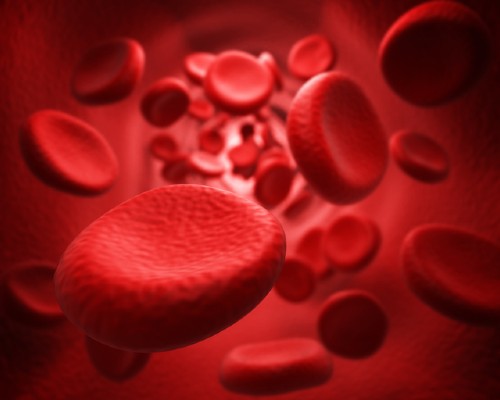Russian storage AERODISK: load testing. Squeeze the IOPS

Hello! As promised, we publish the results of the load test of the Russian-made data storage system – AERODISK ENGINE N2.
In the last article, we broke the storage system (i.e., we performed crash tests) and the crash test results were positive (that is, we never broke the data storage system). The results of the crash test can be found HERE.
In comments to the previous article, there were suggestions for additional – more cunning crash tests. We fixed them all and we will definitely implement them in one of the following articles. At the same time, you can visit our laboratory in Moscow at any time (come by foot or do it remotely via the Internet) and perform these tests yourself (you can even do testing for a specific project :-)). Write to us, consider all the scenarios!
In addition, if you are not in Moscow, you can, however, also take a closer look at our storage system by visiting a free training event at the center of competence in the city closest to you.
Below is a list of upcoming events and the dates of work of the competence centers.
- Yekaterinburg. May 16, 2019. Training workshop. You can register via the link: https://aerodisk.promo/ekb/
- Yekaterinburg. May 20 – June 21, 2019. Competence Center. Come to any working time for a live demonstration of the storage system AERODISK ENGINE N2. The exact address and link to registration will be later. Watch for information.
- Novosibirsk FOLLOW INFORMATION ON OUR SITE or ON HABRA.
October 2019 - Kazan FOLLOW INFORMATION ON OUR SITE or ON HABRA.
October 2019 - Krasnoyarsk. FOLLOW INFORMATION ON OUR SITE or ON HABRA.
November 2019
We also want to share another good news: we finally finally earned our YouTube channel, where you can watch videos from past events. In the same place we regularly post our educational videos.
Test stand
So back to the tests. We upgraded our laboratory storage ENGINE N2, installing additional SAS SSD drives, as well as Front-end Fiber Channel 16G adapters. In a symmetrical way, we have upgraded the server from which we will load, adding the FC 16G adapters there.
As a result, we have in labs a 2-controller storage system with 24 SAS SSD 1.6 TB, 3 DWPD disks, which is connected via SAN switches to a physical Linux-server using FC 16G.
The scheme of the test stand in the figure below.

Testing method
For the best performance on the block access, we will use the DDP (Dynamic Disk Pool) pools, which we once created for the ALL-FLASH systems.
For testing, we created two LUNs with a capacity of 1 TB each with a RAID-10 protection level. We will “spread” each LUN on 12 disks (24 in total) in order to fully utilize the potential of each of the installed disks in the storage system.
LUNs are presented to the server through different controllers in order to maximize the utilization of storage resources.
Each of the tests will last for one hour, and the tests will be performed by the Flexible IO (FIO) program, the FIO data will automatically be uploaded to Excel, in which graphs are already being built, for clarity.
Load profiles
In total, we will perform three tests for one hour without taking into account the warm-up time, to which we allocate 15 minutes (this is exactly what is needed to warm up an array of 24 SSD disks). These tests emulate the most frequently encountered load profiles, in particular, these or those DBMS, video surveillance systems, broadcast media content and backup.
Also in all tests, we deliberately turned off the possibility of caching into RAM on the storage system and on the host. The results, of course, will worsen it, but, in our opinion, in such conditions the test will be more honest.
Test results
Test number 1. Random load in small blocks. Emulation of high-load transactional DBMS.
- Block size = 4k
- Read / write = 70% / 30%
- Number of works = 16
- Queue Depth = 32
- Character load = Full Random
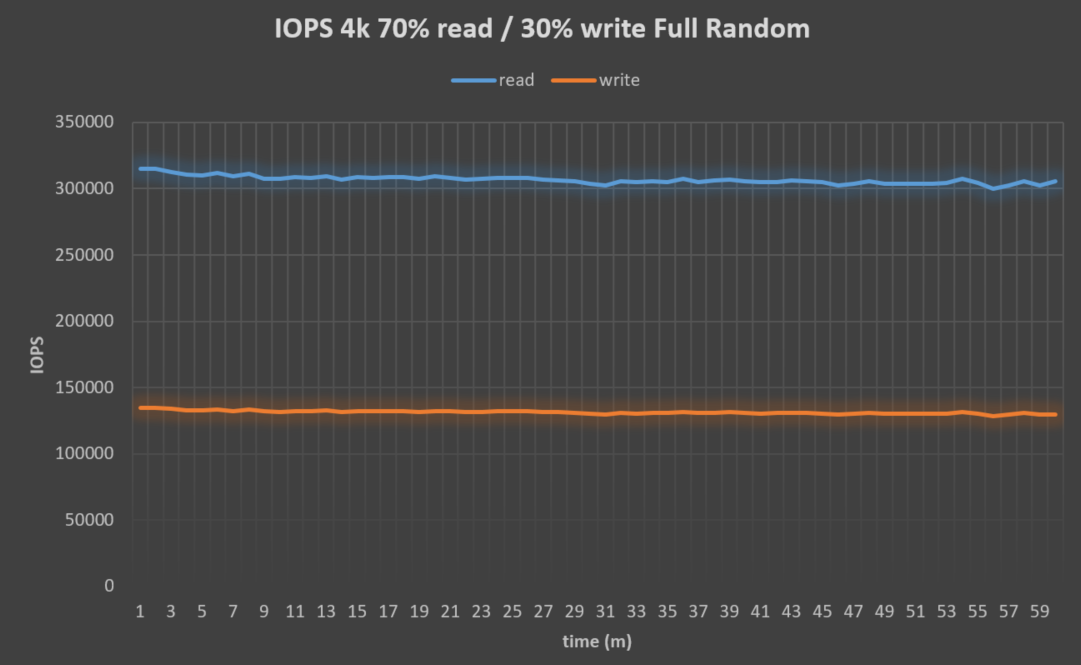
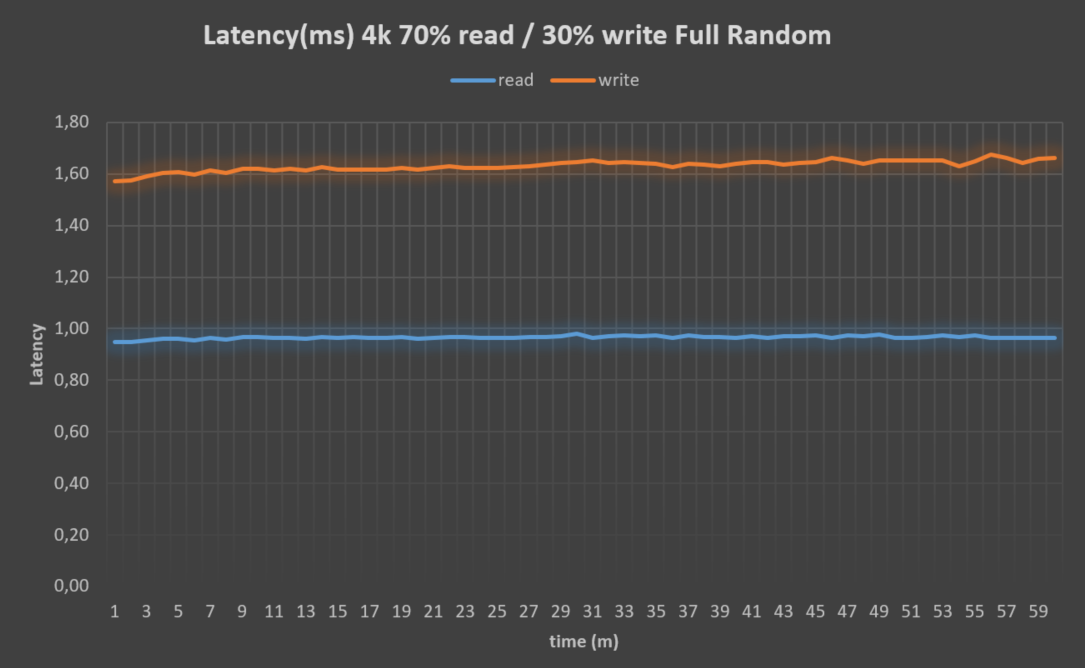
Test results:

Total from the junior mid-range of the Engine N2 system, we received 438k IOPS with a delay of 2.6 milliseconds. Given the class of the system, in our opinion, the result is quite decent. To understand whether this is the limit for the system, we will look at the utilization of storage controller resources.
We are primarily interested in the CPU, because, as stated above, we deliberately disabled the RAM cache so as not to distort the test results.
On both storage controllers, we see roughly the same picture.
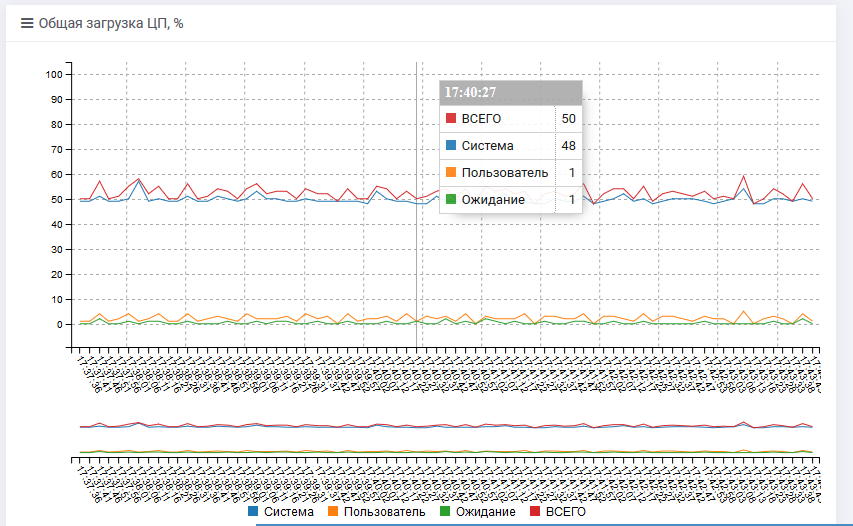
That is, the CPU load is 50%. This suggests that this is still far from the limit of this storage system and you can still safely scale it. Let's run a little ahead: all the following tests also showed a load on the controller processors in the region of 50%, therefore we will not re-bring them.
Based on our laboratory tests, the comfortable limit of the AERODISK Engine N2 system, if we assume random IOPS with 4k blocks is ~ 700 000 IOPS. If this is not enough and you need to strive for a million, then we have the older model ENGINE N4.
That is, the story about millions of IOPS is ENGINE N4, and if a million is too much for you, then calmly use N2.
We return to the tests.
Test number 2. Sequential write large blocks. Emulation of video surveillance systems, loading data into an analytical database or recording backup copies.
In this test, we are no longer interested in IOPSs, since with consistent load in large blocks they do not make any sense. First of all, we are interested in: the recording stream (megabytes per second) and the delays, which with large blocks, of course, will be higher than with small ones.
- Block size = 128k
- Read / write = 0% / 100%
- Number of works = 16
- Queue Depth = 32
- The nature of the load – Sequential
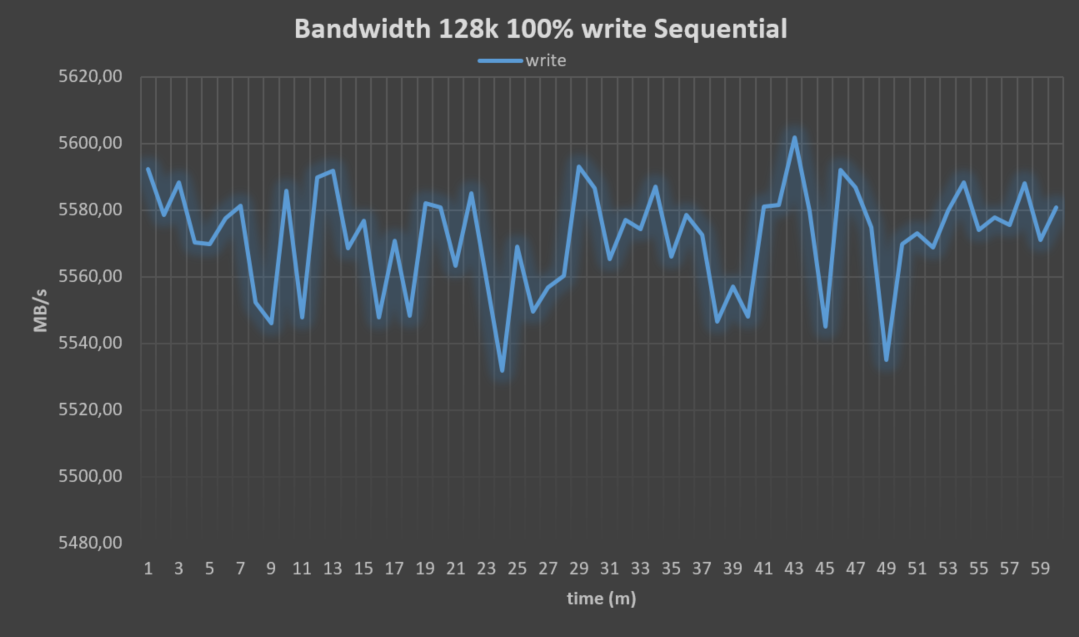


Total: we have a record of five and a half gigabytes per second with delays of eleven milliseconds. If we compare it with our closest foreign competitors, the result, in our opinion, is excellent, and also is not the limit of the ENGINE N2 system.
Test number 3. Sequential reading in large blocks. Emulation of broadcasting media content, generating reports from an analytical database or recovering data from backups.
As in the past test, we are interested in flow and delays.
- Block size = 128k
- Read / write = 100% / 0%
- Number of works = 16
- Queue Depth = 32
- The nature of the load – Sequential



Streaming read performance is predictable slightly better than streaming performance.
Interestingly, the rate of delays in the entire test is identical (straight line). This is not an error, in case of sequential reading in large blocks in our case, this is a common situation.
Of course, if we leave the system in this form for a couple of weeks, we will eventually see periodic jumps on the charts that will be associated with external factors. But, in general, they will not affect the picture.
findings
With the AERODISK ENGINE N2 dual-controller system, we were able to squeeze out quite serious indicators (~ 438,000 IOPS and ~ 5-6 gigabytes per second). Load tests showed that we are definitely not ashamed of our storage. On the contrary, the indicators are very decent and correspond to a good storage system.
Although, as we wrote above, Engine N2 is the youngest model, and besides, the results shown in this article are not its limit. Later we will publish a similar test with our older system ENGINE N4.
Naturally, within the framework of a single article, we cannot cover all possible tests, therefore, we repeatedly call for readers to share their wishes for future tests in the comments, we will definitely take them into account in future publications.
In addition, we remind you that this year we are actively engaged in training, so we invite you to our centers of competence, where you can get training on AERODISK storage systems, and at the same time it's interesting and have fun.
Duplicate information about the next training events.
- Yekaterinburg. May 16, 2019. Training seminar. You can register via the link: https://aerodisk.promo/ekb/
- Yekaterinburg. May 20 – June 21, 2019. Competence Center. Come to any working time for a live demonstration of the storage system AERODISK ENGINE N2. The exact address and link to registration will be later. Watch for information.
- Novosibirsk FOLLOW INFORMATION ON OUR SITE or ON HABRA.
October 2019 - Kazan FOLLOW INFORMATION ON OUR SITE or ON HABRA.
October 2019 - Krasnoyarsk. FOLLOW INFORMATION ON OUR SITE or ON HABRA.
November 2019




